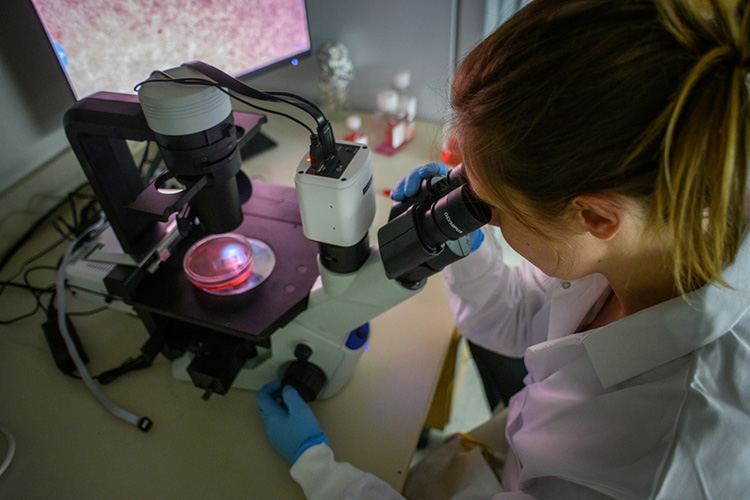
The UAB Division of Transplantation is committed to developing the next generation of surgeon-scientists capable of advancing the field of transplantation for years to come. Our programs have been at the forefront of immunosuppressant development, xenotransplantation, and health disparities research. Our commitment is evidenced by multiple funded studies by the National Institutes of Health (NIH) as well as private industry. Currently, the NIH is funding nearly $8.6 million in studies led by or involving UAB transplant faculty.
-
Anderson, Douglas James, M.D., M.S.
Dr. Douglas Anderson is an Associate Professor in the UAB Division of Transplantation. He also serves as the Program Director for the UAB Abdominal Transplant Fellowship. His areas of interest include kidney transplantation and immunosuppression.
Current projects include:
- "A Prospective, Long-Term Confirmatory Follow Up Trial in Highly Sensitized Patients Treated with Imlifidase or Standard of Care in the ConfIdeS (20HMedIdeS17) Trial"
- "Function in Highly sSnsitized (cPRA >99.9%) Kidney Transplant Patients with Positive Crossmatch Against a Deceased Donor, Comparing Desensitization Using Imlifidase with Standard of Care"
-
Cannon, Robert M., M.D.
Dr. Robert M. Cannon is an Associate Professor in the UAB Division of Transplantation, specializing in liver transplantation and hepatobiliary surgery. His clinical interests include liver transplantation, transplant oncology (liver transplant for HCC, colorectal metastasis, and cholangioarcinoma), elective hepatic surgery, the surgical management of portal hypertension, the surgical management of polycystic liver disease, and the comprehensive management of the full spectrum of benign and malignant hepatobiliary tumors.
Current projects include:
- "UAB Hepatobiliary Tumor Clinical Outcomes"
- "Spatial Epidemiology in Solid Organ Transplantation"
- "Development of a Gut Microbiome-Based Prognostic Signature Predicting Risk of Hepatocellular Cancer"
- "Geographic Variation in Non-HCC MELD Exceptions and Its Effect on Liver Transplant Waitlist Outcomes"
- "Global Utilization and Registry Database for Improved preservation of donor LIVERS (GUARDIAN-LIVER)"
- "OCS Liver Perfusion (OLP) Registry"
- "A Social Determinants of Health Index for Transplant Access"
-
Porrett, Paige, M.D., Ph.D.
In 2020, Dr. Paige Porrett joined UAB as the Director for Clinical & Translational Research for the Comprehensive Transplant Institute. She is the inaugural director of vascularized composite allotransplantation (VCA) for the UAB CTI and has been named the Vera Hauptfeld-Dolejsek Endowed Professor of Transplant Immunology. At UAB, Dr. Porrett began the fourth uterus transplant program in the United States and is recognized as a national and international leader in the field of uterus transplantation. Her NIH-funded immunology laboratory studies maternal immune cell fate and function during pregnancy in both human and animal models. These studies aim to improve pregnancy outcomes in transplant recipients and have focused on multiple immune subsets, including T cells, B cells, NK cells, ILCs, and macrophages. Recently, Dr. Porrett expanded her portfolio to include xenotransplantation and has published the world’s first experience of a clinical-grade, gene-edited porcine kidney transplant into a human being. She also serves as the Project 2 Lead for the U19 project entitled, “Evolution and Durability of Human T and B Cell Responses.”
Current projects include:
- "Graft and Quality of Life Outcomes of Uterus Transplantation"
- "Endometrial Immunobiology in Uterus Transplantation"
- "Mechanisms of Uterine NK Cell Differentiation"
- “Evolution and Durability of Human T and B Cell Responses”
-
MacLennan, Paul, Ph.D.
Dr. Paul MacLennan is an epidemiologist at the University of Alabama at Birmingham, where he is a Professor of Surgery and Associate Director of Transplant Analytics, Informatics & Quality. His experience includes collaborations with researchers with diverse interests, including occupational exposures and mortality/cancer, health disparities, diabetes and vision, healthcare utilization, geriatric epidemiology, injury and trauma and solid organ transplantation. He currently serves as a study design and biostatistics expert in the UAB Center for Clinical and Translational Science, providing methodological consultations campus-wide to faculty, residents and students through the CCTS Biostatistics, Epidemiology and Research Design group. Over the course of his career, he has developed methodological expertise with all epidemiological study designs utilizing both primary and secondary data types from local and national sources for cross-sectional, retrospective, prospective, longitudinal and repeated measures data.
Current projects include:
- "Transplant Data Analysis Center (TDAC) Data Collection for All Renal, Renal/Pancreas, Liver, Intestinal, Heart, Lung and Heart/Lung Transplants"
- "Genetic, Environmental, and Histologic Basis for Kidney Disease Risk among Persons Living with HIV"
-
Sheikh, Saulat Sajjad, M.D.
Dr. Saulat Sheikh joined the UAB Department of Surgery in July 2020 as an Assistant Professor in the Division of Abdominal Transplantation. Dr. Sheikh attended medical school at the Aga Khan University in Karachi, Pakistan where she was conferred the "Best Graduate" award. She subsequently completed her General Surgery Residency at York Hospital, York, Pennsylvania. Dr. Sheikh graduated from the University of Alabama at Birmingham's Abdominal Transplantation and Hepatobiliary Surgery Fellowship in 2020. Her areas of interest include liver transplantation, kidney transplantation, pediatric transplantation, live donor liver transplant, live donor kidney transplant, and hepatobiliary surgery.
Current projects include:
- "Sponsor-Initiated OCS Liver Perfusion (OLP-II) Registry"
-
Young, Carlton J., M.D.
Mark H. Deierhoi Endowed Professor in Surgery Dr. Carlton Young has been a leader in UAB's transplantation program for over 25 years. Dr. Young's clinical work centers around pediatric kidney transplant and vascular access. His research focuses on vascular access outcomes.
Current projects include:
- "Review of Transplant Outcomes in Kidney/Pancreas Recipients at University of Alabama at Birmingham"